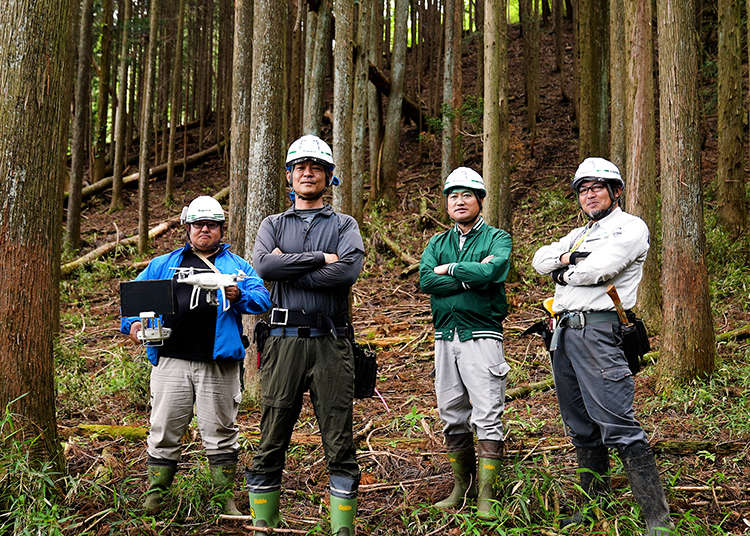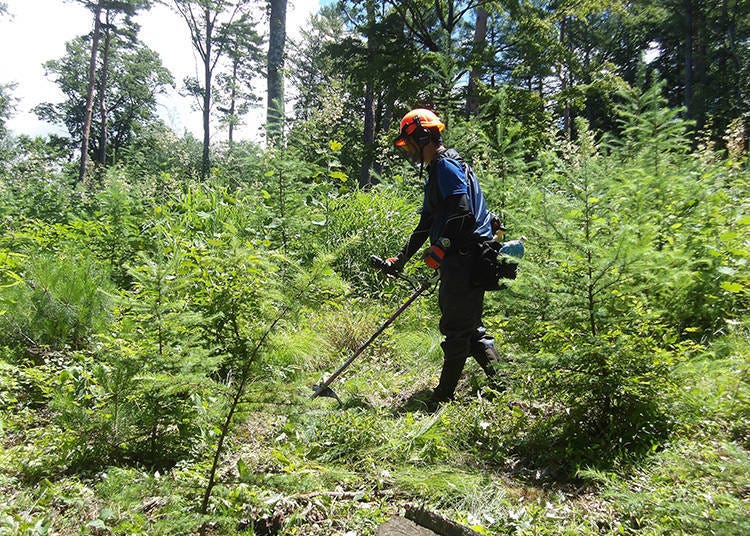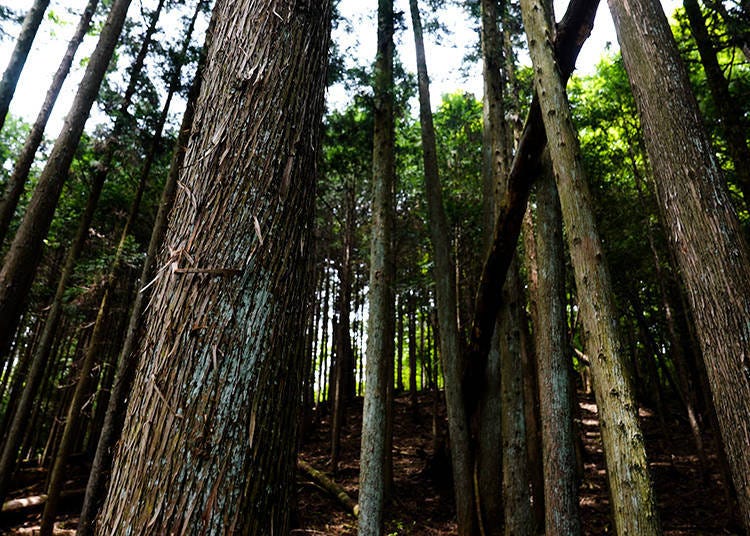
Sustainable Forest Management: Contributing to SDGs and Aiming for Cyclical Use of Forest Resources in Japanese Forestry
- Written by: LIVE JAPAN Editor
With around 70% of its land area covered by forests, Japan is one of the world’s most forested countries. We interviewed the Gunma Prefecture Forestry Cooperative Federations to learn about Japan's forest protection efforts and the cyclical use of forest resources in its forestry industry.
*This article includes advertising content.
Japan’s History with Trees

Surrounded by lush, rich forests, people in Japan have long used wood as a familiar material for making buildings and everyday objects.
This includes timber joinery techniques used to assemble wood without the use of metal fasteners, Sukiya-zukuri (a type of Japanese residential architectural style) that highlights the natural beauty of wood grains, and the creation of lacquerware through meticulous carving and layering of lacquer. Furniture making, too, has evolved based on these ancient woodworking skills.
Japan is a country where many people live in wooden houses and traditional woodworking techniques are deeply ingrained nationwide.
Around the 500s, construction techniques for large-scale wooden structures were developed, and demand for lumber for building temples, shrines, and castles continued to increase.
By the 1600s, as mountains near urban areas began to wither, logging restrictions, forbidding the harvesting of forests, and afforestation began to gradually take place so as to conserve the forests. In addition, it is said that afforestation for forestry purposes began in the 1600s to support the increasing demand for lumber.
Why the Proportion of Forests Remains Unchanged Despite Harvesting

Japan's forests cover around 70% of the nation—a percentage that has remained relatively unchanged for over half a century. Within these woods, there's a staggering 5.4 billion cubic meters of timber—around 60% of which comes from planted forests. Additionally, each year, the accumulated volume of forest resources, primarily in planted forests, is increasing by about 60 million cubic meters.
Maintaining balance is all about the cycle: plant a sapling, let it grow, harvest, use the wood, and then plant another. This looping process is our secret to keeping the forests healthy and ensuring Japan always has a lush environment with renewable resources.

The cycle for these artificial forests spans around 40 to 60 years. It sounds like a long time, but there's a lot of careful tending along the way.
After planting the saplings the first 5 to 6 years involve cutting down weeds and shrubs that might hinder their growth, a process known as underbrush clearing. Then, at about 15 years, they thin out other trees that might be cramping the young forest's style, in a step called “thinning.” By the time 20 to 25 years have passed, they selectively chop down some trees to reduce competition and let others flourish.
Fast forward to 30 to 35 years, and they're at it again with a second round of thinning. By the 40 to 60-year mark, these efforts pay off, and voilà, you've got a splendid, fully-grown planted forest .

The purpose of thinning is “to promote tree growth as well as national land conservation,” says Nobuyuki Takahashi, a member of the Gunma Prefecture Forestry Cooperative Federations.


“Every summer in Japan, typhoons and heavy rains cause damage in many parts of the country, accompanied by disasters such as landslides. By thinning planted forests, we are reducing the risk of sediment runoff by letting light into the soil and allowing weeds to flourish beneath the trees.”
Those involved in Japan’s forestry industry also balance the placement of trees to protect the environment.
Japan’s Smart Forestry Realizes the Future of Forestry


Japan is actively adopting “smart forestry” to manage its vast forests. Smart forestry refers to using geospatial information, internet and communication technology (ICT), robots, and other advanced technologies to improve efficiency and reduce labor in the forestry industry.
A prime example of this is the use of drones in forestry. Drones play an active role in various work sites, one of which is the task of measuring forests. Until now, technicians used to survey the site on foot, but with the introduction of drones, it is now possible to measure the area by analyzing photos taken from the sky. They are also used to transport saplings and deer fences.

Just like drones, laser scanners are also getting a lot of buzz in smart forestry for surveying.
“Before, measuring trees and assessing trees was a labor-intensive task, with people measuring individual trees and inspecting their traits. This approach, especially on steep slopes, had a risk of injury. But now we can use ground-based lasers and get measurements on all the trees in an area,” said Mr. Takahashi.
There's also a push for systems that match timber supply with demand, ensuring that wood is used efficiently and nothing goes to waste.
Contributing to SDGs Through Circular Use of Forest Resources


The artificial forests planted since 1960 are now in their prime for harvesting. The cycle of using and replenishing forest resources is a widespread practice across Japan. For instance, in Gunma Prefecture, saplings were planted, and have been growing strongly. Also, deer eating these planted trees has become an issue in recent years, making wildlife management a critical task for the Forest Owners’ Cooperative Association.

Sustainable forest management that cyclically uses forest resources is attracting attention as an initiative that can contribute to the SDGs and will contribute to Goal 15, “Life on Land.”
Where the Harvested Trees Go: Why Wood Use Contributes to the Mitigation of Global Warming

You’ve probably heard that forests absorb carbon dioxide and contribute to preventing global warming. The leading cause of global warming is said to be the increasing concentration of greenhouse gases, so reducing CO2 emissions into the atmosphere and removing the CO2 already there are key strategies for tackling this issue.
Plants, especially trees in their growth phase, play a key role in combating global warming by absorbing atmospheric carbon dioxide and converting it into organic matter. Trees grow larger by absorbing CO2 through photosynthesis, storing increasing amounts of carbon in their wood.
When this wood is used for products like houses or furniture, the carbon dioxide stays locked up in the wood for a long time instead of being released into the atmosphere. Plus, planting new saplings after harvesting trees kickstarts a new cycle of carbon dioxide removal by forests.
For this reason, using wood from forests where the cyclical use of forest resources is carried out by harvesting, using, and replanting contributes to the SDGs Goal 13, “Climate Action.”
Besides ordinary housing, lumber is also actively used in large buildings and facilities. The use of lumber, which also contributes to the global environment, is attracting attention from enterprises.
The commercial building HULIC &New GINZA 8, located in Ginza, Tokyo, uses Sugi (Japanese cedar) and other domestic timbers for pillars, beams, and ceilings. Also, Tokio Marine & Nichido, a Japanese insurance company, announced that it will use as much domestic lumber as possible for the pillars and floors of its new 20-story building (approx. 100 meters tall), and construction is currently underway for completion in fiscal 2028.

The potential uses of timber are expanding, ranging from everyday household items to large-scale buildings. Blessed with rich forest resources and a long tradition of woodworking skills, Japan offers a variety of wood products crafted with advanced techniques.
We invite you to look at some of the Japanese wood products made using advanced technology.
- Area
- Category
*Prices and options mentioned are subject to change.
*Unless stated otherwise, all prices include tax.
Popular Tours & Activitiess
-

First Japan Cherry Blossom 2026 Forecast Announced! Here's When & Where to See Sakura in Japan
-

How to Get Don Quijote's Exclusive 2025-2026 Winter Gift (+Tax-Free Savings)
-
Ad

Discover the "Miraculous Forest" in the Heart of Tokyo: The Institute for Nature Study (9 Minutes from JR Meguro Station)
-

Strawberries, Style, and Tokyo’s Coolest Neighborhood: Winter Afternoon Tea in Kichijoji
by: Guest Contributor
-

This Winter, Godzilla Takes Over Haneda Airport
by: Guest Contributor
-
Ad

Complete Guide to Ueno's National Museum of Nature and Science, the Perfect Place to Visit on Rainy Days or With Children
Inspiration for Accommodations
-

Enjoy Mt. Fuji from the Comfort of Your Room! Recommended Ryokan with Mt. Fuji View
-

Stay Near the Cherry Blossoms! Hotels for Cherry Blossom Viewing in Tokyo
-

Family-Friendly Hotels with Free Shuttle to Disneyland: Convenient Access for a Magical Stay
-

Top Ranked Hakone Hotels with Mt. Fuji View: Enjoy Stunning Scenery from Your Private Space
-

Convenient Tokyo Hotels with Airport Shuttle: Ideal for Families and Heavy Luggage
-

Stunning Tokyo Tower View Hotels: Enjoy Spectacular Scenery from Your Private Space
-

Convenient Asakusa Hotels with Kitchens: Ideal for Extended Family Visits
-

Experience Luxury: Hakone's 10 Best Five-Star Accommodations
-

Enjoy Mt. Fuji Autumn Leaves! Top Hotels Near the Popular Autumn Leaves Corridor
-

Experience Hakone Fall Foliage from Your Room with Stunning Views
-

8 Iconic Tokyo Locations That Will Make Your Instagram Shine
by: Himanshi Shah
-

Tokyo Tsukiji|Tsukiji Area Map & Sightseeing Information
-

The Easiest One-Day Tokyo Itinerary: Exploring Tokyo on the Yamanote Line
-

JR Edition: Visit all of Tokyo in one Day with the Tokyo Metropolitan District Pass!
-

Tokyo Station Top 10 Sweets Ranking!
-

Best Views in Tokyo: Top 5 Spots for Seeing Tokyo's Iconic Skyline in 1 Day
- #best ramen tokyo
- #what to buy in ameyoko
- #what to bring to japan
- #new years in tokyo
- #best izakaya shinjuku
- #things to do tokyo
- #japanese nail trends
- #what to do in odaiba
- #onsen tattoo friendly tokyo
- #daiso
- #best sushi ginza
- #japanese convenience store snacks
- #best yakiniku shibuya
- #japanese fashion culture
- #best japanese soft drinks












